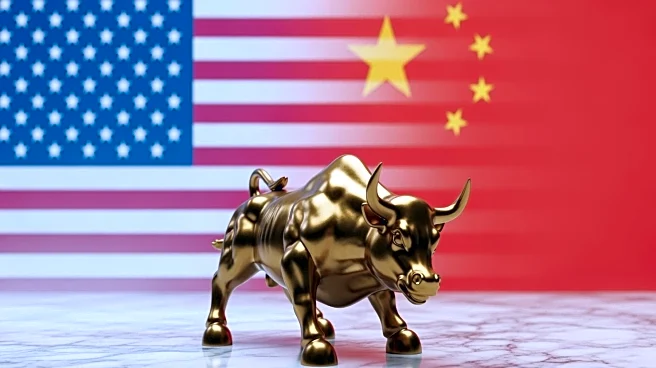What's Happening?
As of October 22, 2025, commodity markets are experiencing slight increases in prices. December corn is up 1¾¢ at $4.21½ per bushel, while November soybeans have risen 1¼¢ to $10.32 per bushel. Wheat prices have also
seen a modest increase, with December CBOT wheat up 2½¢ at $5.02¾ per bushel. The market is closely monitoring developments related to the upcoming meeting between President Trump and President Xi, which is expected to influence market directions. Cole Raisbeck, a commodities broker with Kluis Commodity Advisors, noted the market's sensitivity to headline risks and the potential impact of statements from both leaders and Chinese trade representatives.
Why It's Important?
The anticipated meeting between President Trump and President Xi holds significant implications for global trade relations, particularly affecting agricultural commodities. The U.S. and China are major players in the global market, and any agreements or disagreements could impact trade flows and pricing. The slight uptick in commodity prices reflects market optimism or caution as traders await potential announcements. The outcome of this meeting could influence U.S. farmers and exporters, who rely heavily on stable trade agreements with China. A positive outcome could lead to increased demand and higher prices for U.S. agricultural products, benefiting the farming sector.
What's Next?
Market participants are expected to continue monitoring news related to the meeting between President Trump and President Xi. Any statements or agreements could lead to immediate market reactions, affecting commodity prices and trade strategies. Traders and analysts will be looking for signs of progress in trade negotiations, which could stabilize or further disrupt market conditions. Additionally, stakeholders in the agricultural sector may adjust their production and export plans based on the meeting's outcomes, potentially influencing long-term market trends.
Beyond the Headlines
The meeting between President Trump and President Xi could have broader implications beyond immediate market reactions. It may affect geopolitical relations and set the tone for future trade negotiations between the U.S. and China. The agricultural sector, which has been impacted by previous trade tensions, could see shifts in policy and strategy depending on the meeting's results. Furthermore, the meeting could influence other sectors tied to international trade, such as manufacturing and technology, as both countries navigate complex economic and political landscapes.












